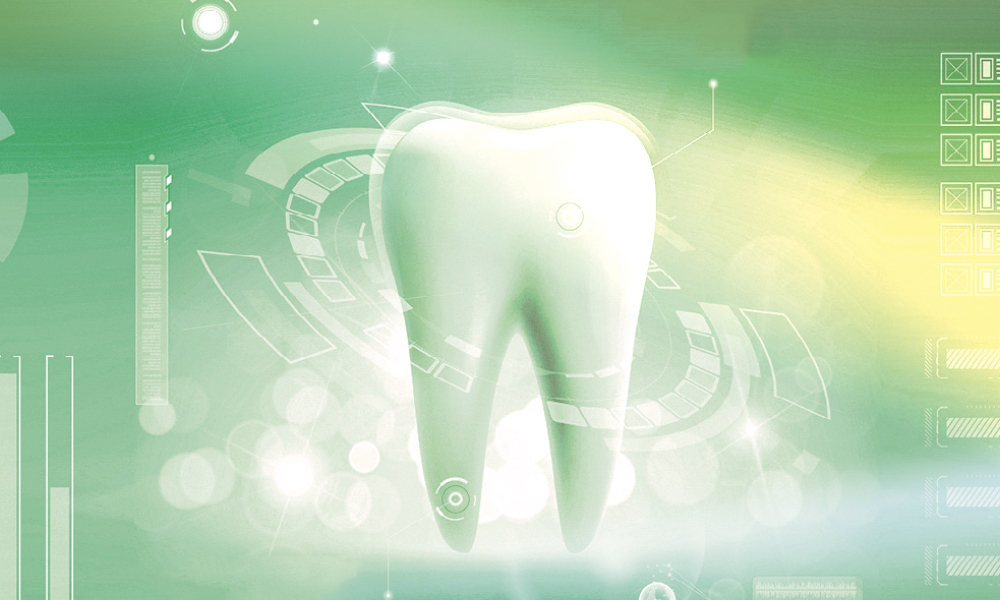Artificial intelligence and dentistry
ADA takes lead role in setting standards for dental practice uses

Artificial intelligence and its implications have been all over the news lately, but what does this technology mean for dentistry?
A white paper released in February by the ADA Standards Committee on Dental Informatics provides an overview of the uses of artificial intelligence and augmented intelligence in dental practice, primarily in the analysis of dental images to aid clinicians in making diagnoses, and the ADA is working on other standards to help guide those uses responsibly.
While artificial intelligence refers to intelligence demonstrated by machines rather than humans, augmented intelligence retains elements of human intelligence in its procedures. Rather than performing an assignment for a clinician like AI might do, augmented intelligence acts as a tool to assist the clinician in the task, according to the white paper.
“While the integration of AI and augmented intelligence in dentistry is progressing, it's important to note that human expertise and clinical judgment remain essential,” said Manny Chopra, D.M.D., chair of the ADA Council on Dental Practice. “Ethical considerations, data privacy and regulatory guidelines are crucial to ensure responsible implementation and protect patient rights.”
However, AI and augmented intelligence offer opportunities to improve patient care, diagnostics and administrative processes, Dr. Chopra said.
“By integrating AI and augmented intelligence, dental practices can provide precise diagnoses, personalized treatments and enhanced patient experiences,” he said. “Currently, the use of AI and augmented intelligence in dentistry is steadily advancing and showing promising potential.”
Dr. Chopra said some uses of AI and augmented intelligence in dentistry include:
• Imaging and diagnosis: Artificial/augmented intelligence algorithms are being developed and deployed to analyze dental images, such as radiographs and intraoral scans, to assist dentists in detecting and diagnosing oral diseases with greater accuracy and efficiency. This technology aids in early detection, leading to timely interventions and improved patient outcomes.
• Treatment planning: Artificial/augmented intelligence-based software can assist dentists in treatment planning by analyzing patient data, case histories and treatment outcomes. These tools provide valuable insights, helping dentists make informed decisions about treatment options, materials and techniques.
• Robotics and automation: Robotics is being explored to automate repetitive tasks in dentistry, such as tooth preparation, implant placement and orthodontic adjustments.
• Virtual reality and augmented reality: These immersive technologies are increasingly used in patient education and treatment visualization. Augmented reality overlays digital information onto the real-world dental environment, assisting dentists during procedures and enhancing accuracy.
• Data analysis and predictive analytics: Artificial/augmented intelligence algorithms can process large amounts of patient data, including medical records, oral health histories and treatment outcomes, to identify patterns and predict future oral health conditions. This enables proactive care, personalized treatment plans and preventive interventions.
• Administrative support: Artificial/augmented intelligence-driven virtual assistants are being employed to streamline administrative tasks in dental practices. These assistants can handle appointment scheduling, patient communication and billing processes to reduce administrative burdens and enhance overall practice efficiency.
“Having standards in place is crucial as the applications and use of AI and augmented intelligence in dentistry grow,” said Michael Saba, D.M.D., chair of the Council on Dental Practice’s Digital Dentistry, Technology and Innovation Subcommittee. “These standards serve as guidelines and frameworks that help ensure ethical and responsible implementation of artificial/augmented intelligence technologies.”
In addition to the recently released SCDI White Paper No. 1106 for Dentistry — Overview of Artificial and Augmented Intelligence Uses in Dentistry, the ADA is working on a technical report and standard related to image analysis systems that use AI and augmented intelligence. The ADA is also developing the U.S. position for the first international standard on AI and augmented intelligence in dentistry.
Dr. Saba said the following reasons point to the importance of standards to the application of AI and augmented intelligence in dental practice:
• Patient safety: Standards help prioritize patient safety by establishing guidelines for the use of AI and augmented intelligence in dentistry. By adhering to these standards, dentists can ensure that artificial/ augmented intelligence systems are accurate, reliable and safe for patients. This includes validating the performance and effectiveness of artificial/augmented intelligence algorithms and systems through rigorous testing and evaluation.
• Data privacy and security: Artificial/augmented intelligence systems in dentistry often rely on sensitive patient data for analysis and decision-making. Standards help establish protocols for data privacy and security, ensuring patient information is protected and handled in compliance with relevant regulations. This helps maintain patient confidentiality and fosters trust in artificial/augmented intelligence technologies.
• Ethical considerations: AI and augmented intelligence can have profound implications for the ethical practice of dentistry. Standards provide guidelines to address ethical concerns, such as the transparency of artificial/augmented intelligence algorithms, the need for informed consent and the mitigation of biases in data and decision-making. These standards promote fairness, accountability and transparency in the use of AI and augmented intelligence in dentistry.
• Interoperability and integration: Standards facilitate the interoperability and integration of artificial/augmented intelligence systems with existing dental technologies and workflows. They help define common data formats, communication protocols and interfaces, allowing seamless integration of AI and augmented intelligence into dental practice. This enables dentists to effectively leverage artificial/augmented intelligence technologies without significant disruptions to their workflow.
• Training and education: Standards play a vital role in guiding the training and education of dentists in the use of AI and augmented intelligence. They provide a foundation for curriculum development and certification programs, ensuring dentists are equipped with the necessary knowledge and skills to understand, evaluate and use artificial/augmented intelligence technologies effectively and responsibly
“Overall, the standards ADA develops in AI and augmented intelligence — and all aspects of dentistry — provide a framework for responsible adoption, implementation and regulation of these technologies,” Dr. Saba said. “They promote patient safety, privacy and ethical considerations while enabling dentists to harness the potential of AI and augmented intelligence to enhance diagnosis, treatment planning and patient care.”
To read the ADA’s white paper on AI and augmented intelligence and learn more about its standards program, visit ADA.org/dentalstandards.



